
| The Foundations Of Social Studies Teaching | |
| An Introduction to the Social Studies: Linking the Past and the Present | |
| Children, Diversity, and Learning: Understanding Your Students | |
| The Transformed Curriculum: Infusing Multicultural Perspectives | |
| The Fundamentals Of Social Studies Teaching | |
| Lesson Plans: Organizing Instruction | |
| Cooperative Learning: Enhancing Skills and Knowledge through Group Activities | |
| Inquiry and Critical Thinking: Challenging Students with the Complex and the Controversial | |
| Technology: Teaching with Computer-Based Resources | |
| Assessment: Acquiring and Analyzing Data on Student Achievement | |
| The Integrated Curriculum: Incorporating the Language Arts, the Performing Arts, and the Visual Arts | |
| Units of Instruction: Putting it All Together to Create a Powerful Social Studies Program | |
| Sources Of Content For Social Studies Teaching | |
| Democratic Citizenship: Participating in Civic Life | |
| History and Geography: Understanding People of Different Times and Places | |
| The Other Social Sciences and Topics of Special Interest: Completing the Social Sciences Curriculum | |
| Children's Literature to Support Social Studies Instruction | |
| References | |
| Index | |
| Table of Contents provided by Publisher. All Rights Reserved. |
The New copy of this book will include any supplemental materials advertised. Please check the title of the book to determine if it should include any access cards, study guides, lab manuals, CDs, etc.
The Used, Rental and eBook copies of this book are not guaranteed to include any supplemental materials. Typically, only the book itself is included. This is true even if the title states it includes any access cards, study guides, lab manuals, CDs, etc.